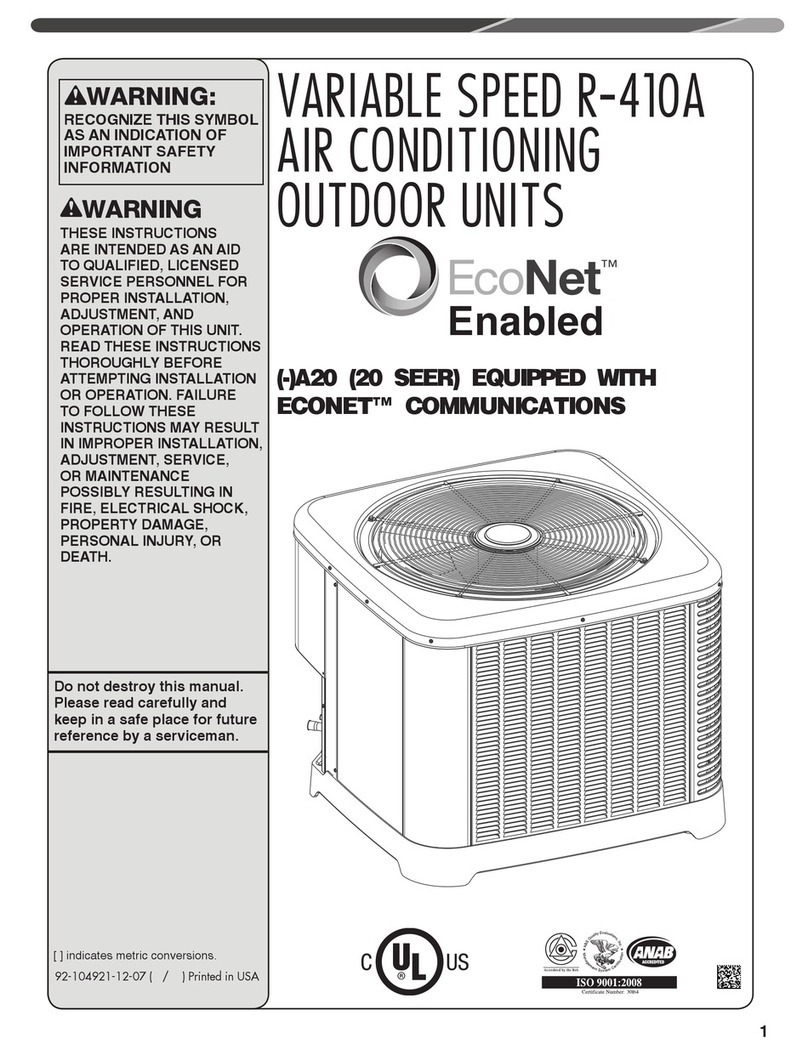
Contents
Important
Safety Information ��������������������������������������������� 3
General Information���������������������������������������� 4-7
Checking Product Received ����������������������������������������4
Application �������������������������������������������������������������������4
Electrical and Physical Data������������������������������������� 5-6
Specifications����������������������������������������������������������� 6-7
Proper Installation ��������������������������������������������������������7
Installation����������������������������������������������������8-22
Choosing a Location��������������������������������������8-10
Operational Issues��������������������������������������������������������8
Corrosive Environment �������������������������������������������������8
For Units With
Space Limitations���������������������������������������������������������9
Customer Satisfaction Issues ��������������������������������������9
Unit Mounting���������������������������������������������������������������9
Factory-Preferred
Tie-Down Method���������������������������������������������������������9
Snow Depth Table ������������������������������������������������������10
Tools and Refrigerant ���������������������������������������11
Tools Required for Installing and
Servicing R-410A Models ������������������������������������������11
Specifications of R-410A �������������������������������������������11
Quick-Reference
Guide for R-410A �������������������������������������������������������11
Replacement Units �������������������������������������������12
Indoor Coil ��������������������������������������������������������12
Location����������������������������������������������������������������������12
Interconnecting Tubing�������������������������������� 12-22
Refrigerant Level Adjustment�������������������������������������12
Interconnecting Tubing and
Fitting Losses �������������������������������������������������������������13
Liquid Line Selection��������������������������������������������������13
Long Line Set Applications ����������������������������������������14
Oil Level Adjustments for Long Line��������������������������14
Suction Line Selection �����������������������������������������������15
Refrigerant Migration During Off Cycle����������������������15
Tubing Installation ������������������������������������������������������20
Tubing Connections ���������������������������������������������������21
Leak Testing ���������������������������������������������������������������22
Wiring ���������������������������������������������������������23-26
EcoNet™ Control Communications���������������������������23
Control Wiring ������������������������������������������������������������23
EcoNet™ Control Board
Communication Wiring���������������������������������������������� 23
Conventional 24VAC Thermostat Control Wiring������ 24
Conventional 24VAC Mode of Operation�������������������24
Typical Noncommunicating Thermostat
Wiring Diagrams���������������������������������������������������������24
Power Wiring ��������������������������������������������������������������25
Grounding�������������������������������������������������������������������26
Start-Up ������������������������������������������������������27-32
Start-Up����������������������������������������������������������������������27
Checking Airflow ��������������������������������������������������������27
Evacuation Procedure ����������������������������������������������� 28
Final Leak Testing�������������������������������������������������������28
Checking Refrigerant Charge ���������������������� 29-32
Charging Units
With R-410A Refrigerant ��������������������������������������������29
Confirm ID Airflow and Coils Are Clean���������������������29
Measurement Device Setup���������������������������������������29
Charging by Weight����������������������������������������������������29
Setting Compressor Speed����������������������������������������30
Gross Charging by Pressures ������������������������������������30
Final Charge by Subcooling ���������������������������������������31
Finishing Up Installation ���������������������������������������������31
Components and Controls��������������������������33-51
Compressor Stator Heat (CSH) �������������������������33
Stator Heat Operation ������������������������������������������������33
High- and Low-Pressure
Controls (HPC and SPT)������������������������������������33
Accumulator ���������������������������������������������������� 34
Outdoor Fan Motors����������������������������������������� 34
Outdoor Fan Blades����������������������������������������� 34
Alternate Suction LINE THERMISTOR ������������� 35
Coil Thermistor������������������������������������������������ 35
Compressor Sump Thermistor������������������������� 35
Suction Pressure Transducer (SPT) ����������������� 36
Discharge Line Thermistor ������������������������������ 36
Power Inverter Compressor Controls �������������� 36
Choke/Inductor������������������������������������������������ 37
Filter & Ferrite Rings ��������������������������������������� 37
EcoNet™ Variable Speed
Unitary Control ������������������������������������������������ 38
Test and SW2 Buttons �����������������������������������������������38
Memory Card �������������������������������������������������������������39
Factory Programmed Superheat��������������������������������39
Compressor Operation�����������������������������������������������40
Active Compressor Protection Mode�������������������������42
Default Operations Upon Component Failure������������49
Test and Fault Recall Modes��������������������������������������49
Agency Test Mode Instructions��������������������������������� 50
Accessories �����������������������������������������������������52
Air Conditioner Thermostat Warning Light Kit ���������� 52
Communicating 2 Wire Kit ���������������������������������������� 52
Diagnostics ������������������������������������������������ 53-73
Replacement of EcoNet™ Variable Speed
Unitary Control Board ����������������������������������������������� 53
ICC Diagnostic Codes������������������������������������������54-57
Electrical, Mechanical Checks Flowcharts ����������58-61
General Troubleshooting Chart ��������������������������������� 62
Service Analyzer Charts ���������������������������������������63-70
ICC Diagnostic Codes������������������������������������������71-72
Cooling and Heating Mode Troubleshooting Tips ���� 73
Wiring Diagram���������������������������������������������������������� 74
2
CONTENTS




























